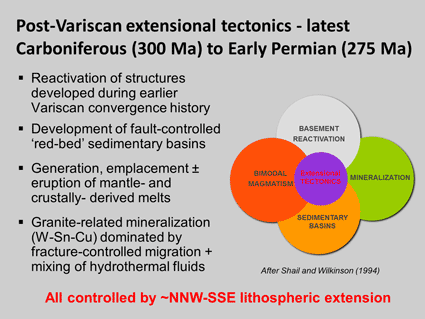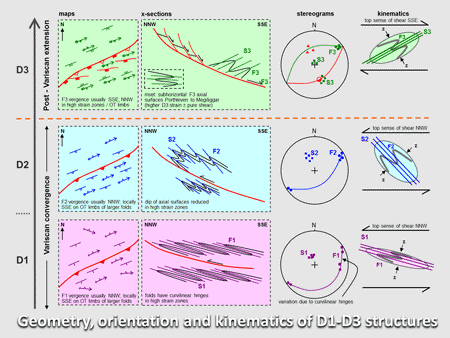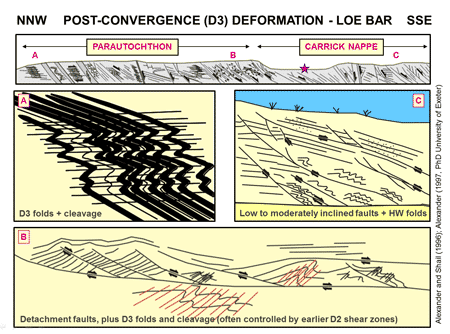- Homepage
- Key Information
- Students
- Staff
- PGR
- Health and Safety
- Computer Support
- National Student Survey (NSS)
- Intranet Help
Prof Robin Shail
SW England post-Variscan tectonics
Variscan convergence ended in the late Carboniferous (c. 305 Ma). It was succeeded across NW Europe by a dextral transtensional regime that persisted through most of the Early Permian. Its effects in SW England were primarily manifested in the extensional reactivation of the Rheic-Rhenohercynian suture, Bristol Channel-Bray Fault and other Variscan thrust faults, and by the strike-slip reactivation of NW-SE Variscan transfer faults. The evidence for reactivation of the offshore Rheic-Rhenohercynian suture zone is summarised by Alexander et al. (2019).
Onshore evidence for latest Carboniferous - Early Permian post-Variscan extension
During this latest Carboniferous - Early Permian extensional episode, a wide variety of regional D3 structures (folds, foliations, faults, shear zones), typically associated with a top-sense-of-shear to the SSE, were developed in Devonian / Carboniferous rocks and the earliest (>289 Ma) Cornubian granites. Descriptions of these structures, their kinematics, position in the regional deformation chronology and timing relative to granite generation and emplacement, are presented in Alexander and Shail (1995), Alexander and Shail (1996) and Hughes et al. (2009). A preliminary evaluation of lineaments across SW England, using Object-Based Image Analysis, which in part reflects the post-convergence history, has been presented by Yeomans et al. (2018).
Consequences of extension for magmatism and sedimentary basin development
The extension brought about lithospheric thinning that resulted in the generation and emplacement of lamprophyres, basalts and granites, and the development of 'red-bed' sedimentary basins (Shail and Wilkinson, 1994; Shail et al. 2003; Shail and Leveridge, 2009; Dupuis et al. 2015; Dupuis et al. 2016; Simons et al. 2016). The relationship between extensional reactivation of the Rhenohercynian-Rheic suture and Early Permian development of Plymouth Bay Basin is addressed by Harvey et al. (1994) and Alexander et al. (2019). The kinematics and palaeostress analyses of both D3 and post-D3 structures, developed during the latest Carboniferous to late-Triassic are summarised in Shail and Alexander (1997).



